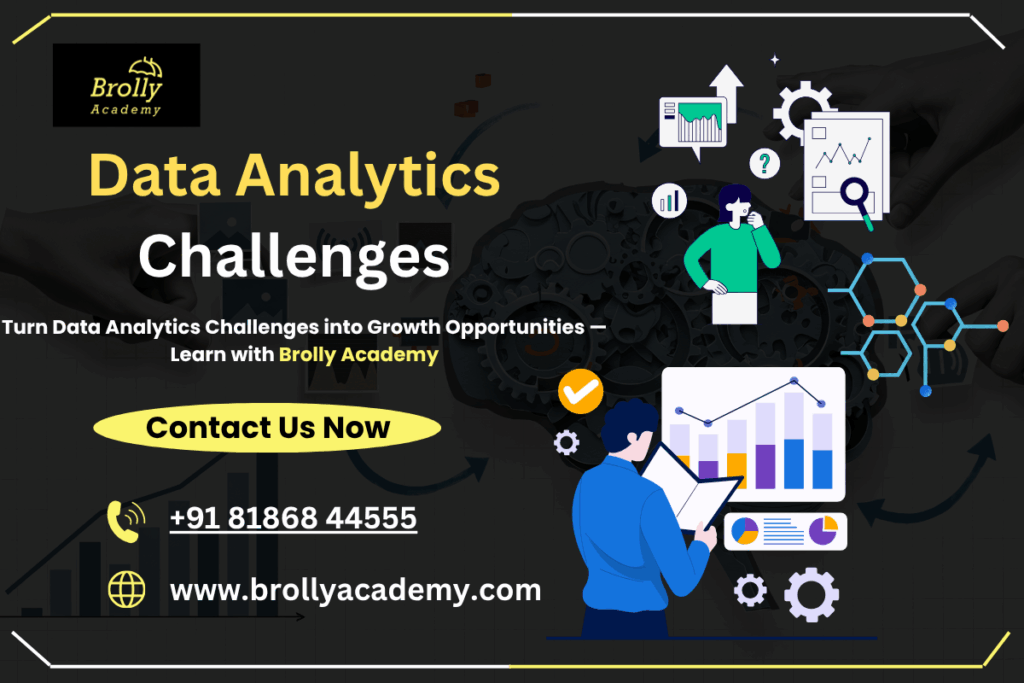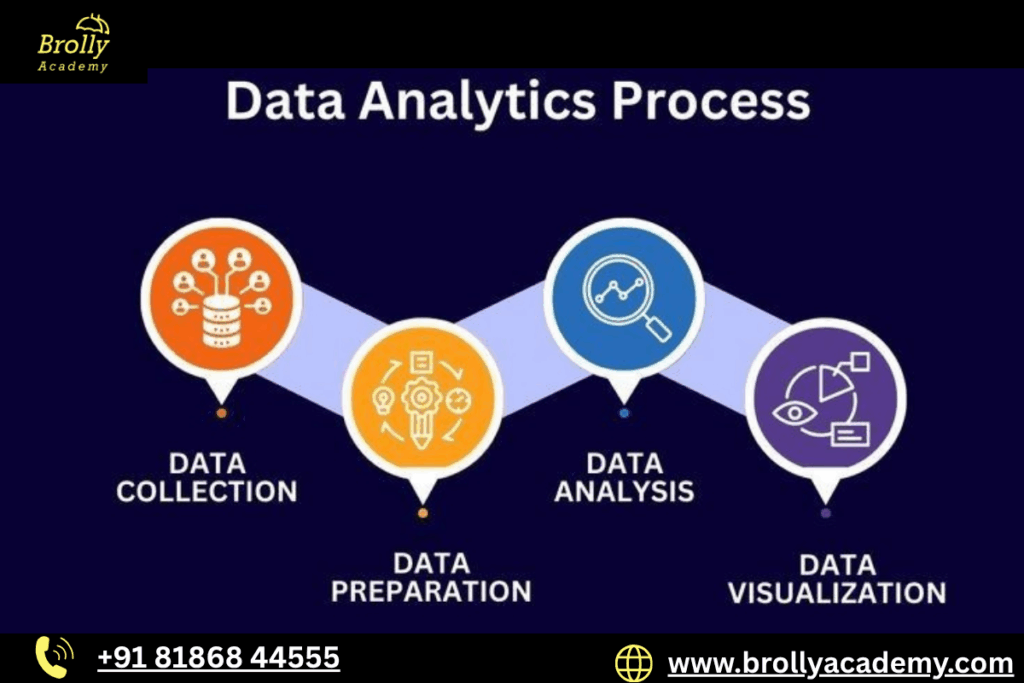Data Analytics Challenges

Table of Contents
ToggleOverview Of Data Analytics Challenges
- Data Analytics Challenges has become the foundation of modern business intelligence, helping organizations turn raw data into actionable insights.
- However, as data sources multiply and technologies evolve, companies face a range of data analytics challenges that hinder decision-making and growth.
- Common issues such as data quality problems, integration of siloed data, and real-time analytics complexities often lead to inaccurate insights and inefficiencies.
- Maintaining data privacy and security compliance has also become critical, with businesses needing to adhere to regulations like GDPR while protecting sensitive information.
- The lack of skilled data professionals further intensifies these problems, making it difficult to fully leverage advanced analytics tools and platforms.
- Moreover, selecting the right technology stack, ensuring strong data governance, and managing the high cost of analytics implementation are ongoing hurdles.
- Overcoming these challenges requires a strategic blend of clean data management, scalable infrastructure, continuous upskilling, and adoption of AI-driven analytics solutions to unlock true business value.This is overview of Data Analytics Challenges
Definition Of Data Analytics
- Data analytics is the process of collecting, organizing, and examining large sets of data to uncover meaningful patterns, correlations, and insights that guide business decisions.
- It involves using advanced analytics tools and technologies like machine learning (ML), artificial intelligence (AI), and data visualization to transform structured and unstructured data into actionable information.
- By applying statistical models, predictive algorithms, and data governance practices, organizations can optimize performance, forecast trends, and enhance customer experiences.
- Now a days, data analytics challenges plays a vital role across industries — enabling smarter strategies, innovation, and measurable growth.
Introduction to the Challenges Faced in Data Analytics
- Despite its growing importance, businesses face several data analytics challenges that impact accuracy and efficiency.
- The most common issues include data quality problems, integration of data from multiple sources, and maintaining data privacy and security in compliance with global regulations.
- Many organizations also struggle with a lack of skilled data professionals, inconsistent data governance, and difficulty in selecting the right analytics tools and technologies.
- As big data continues to expand, managing real-time analytics, reducing implementation costs, and avoiding data misinterpretation have become critical hurdles.
- Overcoming these challenges requires clean data management, advanced infrastructure, and a well-structured analytics strategy that turns raw data into reliable insights.
Understanding the Importance of Data Analytics Challenges
- This data analytics challenges is essential for every organization aiming to make informed and strategic decisions.
- These challenges go beyond technical barriers — they directly influence business growth, decision accuracy, and long-term sustainability.
- By identifying and addressing core issues like data quality, integration of data sources, data privacy, and governance, businesses can turn analytics into a powerful tool for transformation rather than a bottleneck.
A. Impact on Business Decision-Making
- Accurate data analysis is the foundation of effective business decision-making.
- When organizations face data quality issues or poor data integration, the insights generated can become misleading or incomplete.
- These inaccuracies can lead to wrong forecasts, inefficient resource allocation, and missed market opportunities.
- On the other hand, leveraging reliable analytics tools powered by AI and machine learning (ML) enables better trend prediction, operational efficiency, and data-backed decisions.
- Strong data governance and real-time analytics systems ensure that decision-makers access timely and trustworthy insights, creating a solid base for strategic planning and business success.
B. Consequences of Ignoring Data Analytics Challenges
- Ignoring challenges in data analytics can lead to severe setbacks in organizational growth and credibility.
- Poor data privacy management can expose sensitive information, causing legal penalties and reputational loss.
- Similarly, neglecting data integration or allowing data silos to persist results in inconsistent reports and unreliable performance tracking.
- Over time, businesses that fail to invest in the right analytics infrastructure and data governance frameworks risk falling behind competitors who use predictive analytics and AI-driven decision systems.
- Therefore, overcoming these challenges is not optional — it’s a necessity for long-term business sustainability.
C. The Role of Data Analytics in Competitive Advantage
- Effective management of data analytics challenges directly contributes to achieving a competitive advantage.
- Companies that master data quality control, ensure seamless integration of analytics platforms, and prioritize data security gain the agility to make faster, smarter decisions.
- Through advanced AI analytics, business intelligence tools, and predictive modeling, these organizations can anticipate customer needs, improve efficiency, and innovate ahead of market trends.
- In a digital-first economy, the ability to harness data responsibly and strategically defines industry leaders — making strong analytics practices a key differentiator in 2025 and beyond.

Key Data Analytics Challenges
- As organizations increasingly rely on data analytics to guide strategic decisions, they encounter several challenges that affect accuracy, efficiency, and trust.
- Understanding these key data analytics challenges helps businesses build stronger frameworks, enhance governance, and drive innovation through reliable insights.
A. Data Quality Issues in Analytics
1. Sources of Data Quality Problems
- Poor data quality arises from inaccurate data entry, outdated databases, missing values, and inconsistent data collection across systems.
- When multiple data streams merge without validation, data duplication and incomplete records become common.
- These issues often stem from legacy systems, lack of data cleansing processes, and improper data governance practices.
2. Effects on Analysis and Decision-Making
- Inaccurate data leads to faulty analytics and misguided decisions.
- Business leaders may rely on misleading patterns, resulting in financial loss or missed opportunities.
- High-quality data ensures precision in predictive analytics, AI models, and business intelligence dashboards, making it the cornerstone of reliable decision-making.
B. Data Integration and Silos
1. Challenges of Integrating Disparate Data Sources
- Organizations use multiple platforms and databases that store data in varied formats.
- Combining them into a unified view is complex due to compatibility issues, lack of standardization, and differing data structures.
- Effective data integration demands strong APIs, ETL (Extract, Transform, Load) processes, and cloud-based solutions.
2. Consequences of Data Silos on Analytics
- When departments operate in isolation, data silos prevent the flow of critical information.
- This fragmentation limits visibility, reduces collaboration, and slows down analytics workflows. Breaking down silos enhances real-time decision-making and creates a holistic view of business performance.
C. Data Privacy and Security Concerns
1. Importance of Data Protection
- With rising cyber threats, maintaining data privacy and security has become vital.
- Businesses handle sensitive information that must be protected from breaches and misuse.
- Implementing encryption, multi-factor authentication, and secure data storage helps safeguard user trust.
.
2. Regulatory Compliance Issues
- Compliance with frameworks like GDPR, HIPAA, and ISO 27001 is mandatory for handling customer data.
- Non-compliance leads to heavy penalties and reputational damage.
- A robust data governance policy ensures that organizations stay compliant while maintaining transparency in analytics operations.
D. Lack of Skilled Data Professionals
1. Shortage of Qualified Personnel
- The growing demand for data scientists, AI engineers, and analytics experts has created a significant skills gap.
- Many organizations struggle to find professionals with expertise in big data tools, cloud analytics, and machine learning algorithms.
2. Impact on Analytics Capabilities
- Without the right talent, companies face delays in implementing analytics projects and interpreting insights accurately.
- Investing in training programs and adopting automated analytics tools can reduce dependency and boost productivity.
E. Real-Time Data Processing and Scalability
1. Challenges in Processing Large Volumes of Data
- Handling massive datasets from IoT devices, social media, and enterprise systems is difficult.
- Real-time data streaming and big data processing require scalable cloud infrastructures and high-performance computing resources.
2. Importance of Scalability in Analytics Solutions
- Scalability ensures that analytics platforms handle growing workloads without compromising speed or accuracy.
- Cloud-based analytics and distributed computing frameworks like Hadoop and Spark enable smooth scaling and real-time decision-making.
F. Choosing the Right Analytics Tools and Technologies
1. Factors to Consider in Tool Selection
- Selecting the right analytics tools depends on business size, data volume, and analytical goals.
- Key factors include scalability, integration compatibility, ease of use, and support for AI-driven insights.
2. Common Pitfalls in Technology Adoption
- Rushing into technology adoption without a clear strategy leads to poor ROI and underutilization.
- Businesses should avoid investing in complex tools without skilled users or clear objectives.
G. Misinterpretation of Insights and Visualization Pitfalls
1. Risks of Poor Data Visualization
- Improper data visualization can distort insights, leading to incorrect conclusions.
- Using unclear charts or ignoring context can mislead decision-makers.
- Visual accuracy is essential for conveying meaningful insights effectively.
2. Importance of Accurate Interpretation of Data
- Analytics teams must understand statistical outcomes and patterns correctly.
- Misinterpreting AI predictions or correlation-based data can lead to costly strategic errors.
- Data literacy training helps ensure accurate interpretation across teams.
H. Data Governance and Compliance Challenges
1. Necessity of Data Governance Frameworks
- A strong data governance framework ensures consistency, accountability, and compliance across all departments.
- It defines who owns, accesses, and manages data throughout its lifecycle.
2. Compliance with Industry Regulations
- Industries such as healthcare, finance, and e-commerce must follow strict data compliance standards.
- Regular audits, documentation, and ethical data use strengthen organizational credibility and reduce legal risks.
I. High Implementation Costs
1. Financial Implications of Analytics Solutions
- Implementing advanced data analytics systems involves significant expenses — from software licensing and data storage to hardware upgrades and personnel training.
2. Cost-Benefit Analysis of Investing in Analytics
- Despite high upfront costs, data analytics delivers measurable ROI through improved efficiency, predictive insights, and better decision-making.
- Businesses should adopt phased implementation and cloud-based models to optimize expenses.
J. Keeping Up with Evolving Technologies
1. Rapid Technological Advancements
- The field of data analytics is evolving rapidly with innovations in AI, machine learning, natural language processing (NLP), and real-time analytics.
- Staying updated is crucial to remain competitive.
2. Strategies for Staying Current
- Continuous learning, partnerships with tech vendors, and regular system upgrades help organizations stay ahead.
- Embracing cloud-native analytics and AI automation ensures adaptability and future readiness.

Solutions and Best Practices Of Data Analytics Challenges
- Overcoming data analytics challenges requires a well-structured approach combining technology, strategy, and skilled professionals.
- The following best practices and solutions help organizations enhance data accuracy, maintain privacy, strengthen analytics workflows, and build a culture of data-driven decision-making.
A. Strategies for Improving Data Quality
- Maintaining high-quality data begins with proper collection, validation, and cleansing.
- Organizations should implement data profiling tools to detect duplicates, missing values, and inconsistencies.
- Regular audits, automated validation scripts, and AI-driven data cleaning systems enhance reliability.
- Establishing data ownership and enforcing data governance policies ensures ongoing accuracy and consistency across departments.
B. Approaches to Effective Data Integration
- For seamless data integration, businesses must adopt cloud-based ETL tools and APIs that unify disparate data sources.
- Using data lakes and data warehouses simplifies access to structured and unstructured data. Standardizing data formats and leveraging integration platforms like Apache Kafka or Talend improves real-time analytics.
- Breaking down data silos enables cross-functional insights and better collaboration.
C. Enhancing Data Privacy and Security Measures
- To protect sensitive information, companies should enforce data encryption, access controls, and multi-factor authentication.
- Regular vulnerability assessments and compliance with standards like GDPR and HIPAA safeguard user trust.
- Investing in cybersecurity analytics and AI-based threat detection helps proactively identify and mitigate security risks while maintaining transparency and accountability.
.
D. Building a Skilled Data Analytics Team
- Addressing the talent gap requires a mix of hiring and upskilling.
- Organizations should invest in training programs that strengthen data literacy, machine learning, and AI analytics skills.
- Collaboration between IT, data science, and business teams enhances understanding of organizational goals.
- Encouraging continuous learning and certification ensures a future-ready analytics workforce.
E. Implementing Real-Time Data Processing Solutions
- Leveraging real-time analytics allows businesses to make faster, smarter decisions.
- Tools like Apache Spark, Flink, and cloud streaming platforms enable instant data processing. Implementing edge computing and cloud scalability ensures efficient handling of high data volumes.
- Continuous monitoring and performance tuning help maintain accuracy and speed in live analytics environments.
F. Selecting Appropriate Analytics Tools
- Choosing the right analytics tools and technologies depends on scalability, integration ease, and cost-effectiveness.
- Businesses should evaluate solutions based on features like AI automation, data visualization, and predictive analytics capabilities.
- Tools such as Tableau, Power BI, and Google BigQuery offer intuitive dashboards and deep analytical insights that empower decision-making.
G. Best Practices for Data Visualization
- Effective data visualization turns complex analytics into understandable insights.
- Use clear charts, color-coded visuals, and interactive dashboards to tell meaningful data stories. Avoid cluttered designs and ensure accessibility for all users.
- Combining visual analytics with business intelligence tools helps decision-makers interpret trends accurately and take prompt action.
H. Establishing Robust Data Governance Frameworks
- A strong data governance framework ensures accountability, compliance, and consistency.
- Define data ownership roles, implement access policies, and create documentation for every data process.
- Integrating metadata management and data lineage tracking enhances transparency.
- Regular governance audits strengthen security and ensure that analytics align with regulatory standards.
I. Budgeting for Analytics Implementation
- Effective budgeting is key to long-term analytics success.
- Organizations should perform a cost-benefit analysis before adopting new tools or cloud infrastructures.
- Start small with scalable models like Software-as-a-Service (SaaS) and gradually expand based on ROI.
- Prioritize spending on automation, training, and cybersecurity to maximize analytics impact within budget.
J. Continuous Learning and Adaptation to New Technologies
- The data analytics landscape evolves rapidly, with innovations in AI, machine learning, and predictive modeling.
- Companies must embrace a culture of continuous learning to stay ahead. Encourage employees to pursue certifications, attend webinars, and explore emerging technologies.
- Investing in R&D and adopting AI-driven analytics platforms ensures that businesses remain competitive and future-ready.
Conclusion: Overcoming Data Analytics Challenges for a Smarter Future
- Overcoming data analytics challenges is no longer optional — it’s essential for sustainable business growth.
- Organizations that address key issues like data quality, integration of disparate systems, data privacy, and governance unlock the full potential of their analytics capabilities.
- By adopting AI-powered analytics tools, building skilled teams, and implementing real-time data processing, businesses can transform raw data into powerful, actionable insights.
- The future of data analytics lies in agility, accuracy, and adaptability. Companies that invest in data literacy, automation, and continuous improvement will gain a lasting competitive advantage in their industries.
- As technology evolves, embracing innovation and ethical data management practices will empower organizations to make smarter decisions, foster customer trust, and drive measurable success in the digital age.
FAQs
1. What are the biggest challenges in data analytics?
The major data analytics challenges include poor data quality, integration issues, data privacy concerns, lack of skilled professionals, and high implementation costs.
2. Why is data quality important in analytics?
Accurate data ensures reliable insights and better decision-making, while poor data quality can lead to misleading conclusions.
3. How do data silos affect analytics performance?
Data silos limit collaboration, cause inconsistency, and prevent a unified view of business insights.
4. What causes poor data quality in analytics?
Common causes include missing values, duplicate entries, inconsistent formatting, and outdated information.
5. How can organizations improve data integration?
By using ETL tools, cloud-based integration platforms, and standardized data formats to unify multiple sources.
6. What are the main data privacy and security concerns?
Key concerns include unauthorized access, data breaches, and non-compliance with GDPR and HIPAA regulations.
7. How does a lack of skilled professionals impact analytics?
Without trained experts, businesses struggle to interpret data accurately and implement advanced AI-driven analytics effectively.
8. What is the role of real-time data processing in analytics?
Real-time analytics helps organizations make instant, data-driven decisions that improve agility and performance.
9. Why is scalability important in data analytics?
Scalable analytics systems handle large, fast-growing datasets efficiently without affecting processing speed.
10. How can companies ensure data governance?
By creating clear ownership rules, implementing governance frameworks, and conducting regular data audits.
11. What are the financial challenges in implementing analytics?
High costs of software, cloud infrastructure, and skilled labor often make data analytics implementation expensive.
12. How can businesses reduce analytics implementation costs?
Using cloud-based models, open-source tools, and phased adoption helps minimize upfront investment.
13. What is the importance of accurate data visualization?
Effective data visualization helps simplify complex insights, making data easy to understand and act upon.
14. How can poor visualization lead to misinterpretation?
Using unclear or biased visuals may distort insights, leading to wrong business decisions.
15. What are common pitfalls in choosing analytics tools?
Choosing tools without scalability, integration compatibility, or proper user training leads to poor ROI.
16. How can AI help solve data analytics challenges?
AI and machine learning automate data cleaning, improve predictions, and enhance decision accuracy.
17. What are some best practices for ensuring data privacy?
Encrypting data, setting role-based access, and complying with global data protection regulations ensure strong privacy.
18. How can organizations handle large data volumes efficiently?
By leveraging big data platforms like Hadoop, Spark, and cloud computing for high-speed processing.
19. Why do businesses need a data governance framework?
It ensures data consistency, accountability, compliance, and reliability across all departments.
20. How can real-time analytics improve business outcomes?
Real-time analytics helps detect patterns instantly, optimize operations, and respond quickly to market changes.
21. What challenges do businesses face with evolving technologies?
Rapid changes in AI, ML, and cloud analytics make it difficult to stay current and maintain compatibility.
22. How can companies stay updated with new analytics trends?
By investing in continuous learning, certifications, and collaborations with tech partners.
23. What are the consequences of ignoring data analytics challenges?
Neglecting challenges leads to poor insights, reduced competitiveness, and lost business opportunities.
24. How does data analytics give a competitive advantage?
When challenges are overcome, analytics enables better forecasting, innovation, and customer understanding.
25. How can predictive analytics reduce decision errors?
By using historical data and AI models, predictive analytics forecasts outcomes with higher accuracy.
26. What are key metrics to track in analytics performance?
Metrics include data accuracy, processing speed, ROI, user adoption rate, and model efficiency.
27. How do cloud-based analytics tools improve scalability?
Cloud platforms provide on-demand resources, faster processing, and flexible scalability for big data.
28. What are the skills required for a successful analytics team?
Experts should know Python, SQL, AI/ML models, data visualization, and data governance practices.
